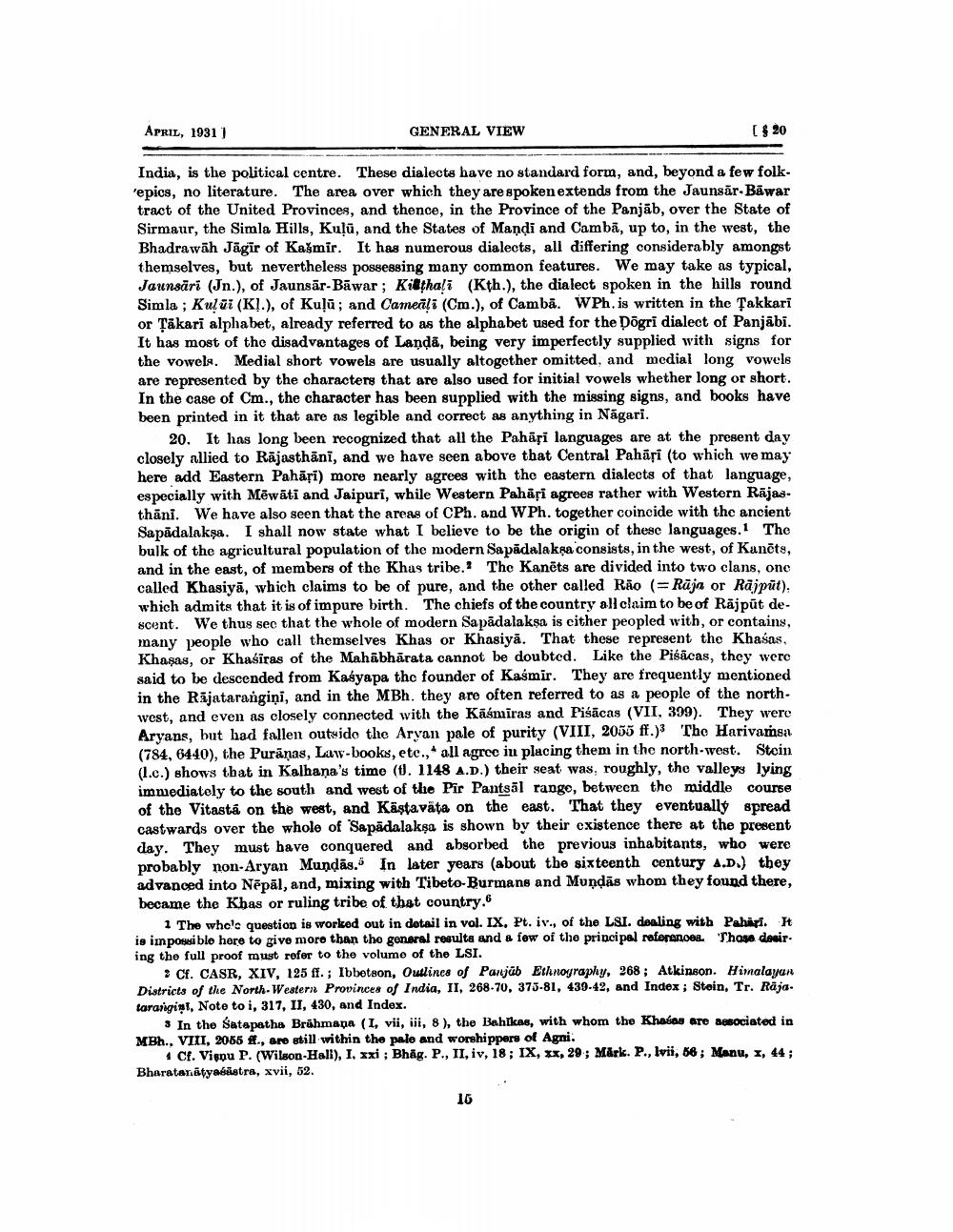________________
APRIL, 1931]
India, is the political centre. These dialects have no standard form, and, beyond a few folk'epics, no literature. The area over which they are spoken extends from the Jaunsar-Bawar tract of the United Provinces, and thence, in the Province of the Panjab, over the State of Sirmaur, the Simla Hills, Kulu, and the States of Mandi and Camba, up to, in the west, the Bhadrawah Jagir of Kašmir. It has numerous dialects, all differing considerably amongst themselves, but nevertheless possessing many common features. We may take as typical, Jaunsari (Jn.), of Jaunsar-Bawar; Kithali (Kth.), the dialect spoken in the hills round Simla; Kului (K!.), of Kuļu; and Cameāli (Cm.), of Camba. WPh. is written in the Takkari or Takari alphabet, already referred to as the alphabet used for the Dogri dialect of Panjabi. It has most of the disadvantages of Landa, being very imperfectly supplied with signs for the vowels. Medial short vowels are usually altogether omitted, and medial long vowels are represented by the characters that are also used for initial vowels whether long or short. In the case of Cm., the character has been supplied with the missing signs, and books have been printed in it that are as legible and correct as anything in Nagari.
GENERAL VIEW
[ $ 20
20. It has long been recognized that all the Pahari languages are at the present day closely allied to Rajasthani, and we have seen above that Central Pahari (to which we may here add Eastern Pahari) more nearly agrees with the eastern dialects of that language, especially with Mewati and Jaipuri, while Western Pahari agrees rather with Western Rājasthani. We have also seen that the areas of CPh. and WPh. together coincide with the ancient Sapadalakṣa. I shall now state what I believe to be the origin of these languages.1 The bulk of the agricultural population of the modern Sapadalakṣa consists, in the west, of Kanēts, and in the east, of members of the Khas tribe. The Kanets are divided into two clans, one called Khasiya, which claims to be of pure, and the other called Rão (=Raja or Rājpūt). which admits that it is of impure birth. The chiefs of the country all claim to be of Rajput descent. We thus sec that the whole of modern Sapadalakṣa is either peopled with, or contains, many people who call themselves Khas or Khasiya. That these represent the Khasas, Khasas, or Khasiras of the Mahabharata cannot be doubted. Like the Pisacas, they were said to be descended from Kasyapa the founder of Kasmir. They are frequently mentioned in the Rajatarangiņi, and in the MBh. they are often referred to as a people of the northwest, and even as closely connected with the Kasmiras and Pisacas (VII, 399). They were Aryans, but had fallen outside the Aryan pale of purity (VIII, 2055 ff.)3 The Harivamsa (784, 6440), the Puranas, Law-books, etc., all agree in placing them in the north-west. Stein (1.c.) shows that in Kalhana's time (fl. 1148 A.D.) their seat was, roughly, the valleys lying immediately to the south and west of the Pir Pantsal range, between the middle course of the Vitasta on the west, and Kästaväta on the east. That they eventually spread castwards over the whole of Sapädalakṣa is shown by their existence there at the present day. They must have conquered and absorbed the previous inhabitants, who were probably non-Aryan Mundas. In later years (about the sixteenth century A.D.) they advanced into Nepal, and, mixing with Tibeto-Burmans and Mundās whom they found there, became the Khas or ruling tribe of that country."
1 The who's question is worked out in detail in vol. IX. Pt. iv., of the LSI. dealing with Pahari. It is impossible here to give more than the general results and a few of the principal references. Those desir ing the full proof must refer to the volume of the LSI.
Cf. CASR, XIV, 125 ff.; Ibbetson, Outlines of Panjab Ethnography, 268; Atkinson. Himalayan Districts of the North-Western Provinces of India, II, 268-70, 375-81, 439-42, and Index; Stein, Tr. Raja. tarangint, Note to i, 317, II, 430, and Index.
3 In the Satapatha Brahmana (I, vii, iii, 8), the Bahikas, with whom the Khasas are associated in MBH., VIII, 2055 ., are still within the pale and worshippers of Agni.
4 Cf. Vienu P. (Wilson-Hali), I, xxi; Bhag. P., II, iv, 18; IX, xx, 29; Märk. P., lvii, 56; Manu, x, 44; Bharatanatyasastra, xvii, 52.
15




